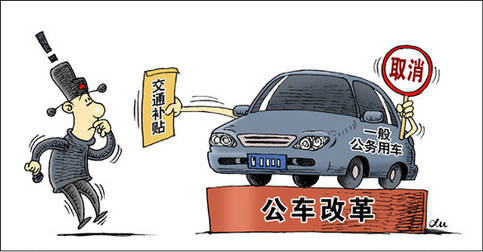根据安排,去年年底前,中央和国家接管的公车改革要基本完成。根据规定,中央和国家机关“车补”标准为:司局级每人每月1300元,处级每人每月800元,科级及以下每人每月500元。
请看《中国日报》的报道:

Instead of having cars provided by the government, officials at bureau level will receive monthly traffic subsidies of 1,300 yuan, while those at director level and section level will get 800 yuan and 500 yuan a month, according to the new guideline to rein in vehicle expenses for the central government.
根据最新的控制中央政府交通费用的指导意见,取消一般公务用车,司局级每人每月领取“车补”1300元,处级每人每月800元,科级及以下每人每月500元。
这里的“车补”是公车补助的缩写,即“公务交通费用”,可以用traffic subsidy表示。而公车,即由政府财政为各级党政机关及事业单位工作人员执行公务需要所配备的车辆,可以用government vehicle/official car表示。
公车改革实为厉行节俭反对浪费,打击“公车腐败”(corruption involving government vehicles/corruption in use of government vehicles)。公车腐败具体的表现形式包括:公车私用(government cars used for private purpose)、私车消费公家报销(reimbursement of private car expenses)、公车照坐,车补照发(irregular subsidies)、公车浪费(waste involving government vehicles)、公车采购追求豪华(purchase of excessively luxurious cars)以及公车数量超标(an excessive number of government vehicles)等。
如今,中央和国家机关车改的车补已经落定,地方车改也将陆续进行。车补能否有效根除滥用特权车(root out abuse of vehicle privileges),节省公帑(save public money),需要各地方政府将中央方针政策与地区实际紧密结合。
(中国日报网英语点津 刘秀红)